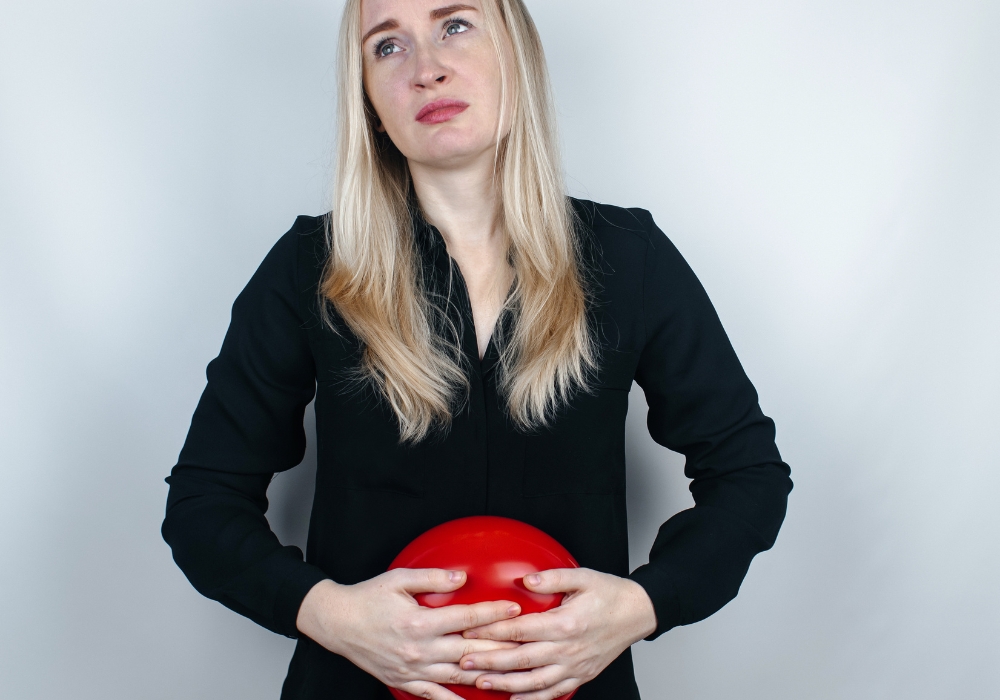
Endo belly is a term used to describe the severe abdominal distension that people with endometriosis often experience. Often described as “looking 6 months pregnant”, endo belly is not only extremely uncomfortable but can be emotionally distressing as well. Although it feels like you don’t have any control over endo belly when it happens, there are many dietary strategies you can use to ease the frequency and severity in which you experience it.
What Causes Endo Belly?
Endo belly is thought to be caused by inflammation, tissue irritation from adhesions or growths and gas or stool buildup from the digestive distress that often accompanies endometriosis.
People with endometriosis are also much more likely to suffer from Small Intestine Bacterial Overgrowth (“SIBO”). SIBO is an overgrowth of bacteria in the small intestine that causes bloating, gas, constipation or diarrhea. It occurs when motility of the small intestine is compromised. With endometriosis, inflammation and adhesions on or near the small intestine can compromise the motility of the small intestine, allowing bacteria to overgrow. Telltale signs of SIBO are bloating within 20 to 40 minutes of eating and intolerance of fibrous foods like apples, onion, garlic and wheat.
“Diet is the most powerful tool you have for fighting endo belly because what you eat targets the root causes: inflammation and GI distress”
With the right dietary tweaks, you can reduce inflammation and eliminate gas, bloating and constipation that causes endo belly. Here are a few tips to get you started:
Cut Back on Highly Refined Sugar & Carbohydrates
Foods that contain highly refined sugar and carbohydrates like cakes, cookies, candies and chocolate contribute to inflammation. Does that mean you can never partake in a birthday cake celebration ever again? No, but these foods shouldn’t be part of your diet every day. Limit them to special occasions and in small amounts. If you have a sweet tooth, opt for treats sweetened with stevia, monk fruit, dates, maple syrup or honey.
Eat More Fiber, But Only The Right Types
Fiber is king for keeping things moving at the right pace through your gastrointestinal tract but that doesn’t mean you should eat it in large amounts indiscriminately. There are certain types of fiber that might make you feel more bloated, gassy and constipated especially if you have SIBO.
So while you should aim to eat a diet rich with vegetables, fruit, whole grains, legumes, nuts and seeds, know that there is a group of fibers called FODMAPs that can cause GI distress. FODMAP is an acronym for a group of carbohydrates that some people are not able to digest. When eaten, they draw water into the gastrointestinal tract and cause a lot of gas production. FODMAPs are found in plant foods only.
The foods that are highest in FODMAPs are apples, pear, mango, stone fruits like peach, mushrooms, cauliflower, garlic, onion, wheat & wheat products, milk & yogurt, cashews, pistachios and beans like kidney beans.
If you eat these foods without issue, there is no need to stop eating them. If you notice you feel more bloated when you eat ‘healthy’ however, look at how many of these foods you eat on a daily basis and consider eliminating them for two weeks.
Be Mindful of Snacking
The mechanism in the gastrointestinal tract that sweeps bacteria and food through the small intestine only works when we are not eating. Frequent snacking or grazing stops this mechanism from doing its job. This includes drinking anything but herbal tea or water between meals. To aid in good motility, aim for three hours in between finishing your last meal or snack and starting your next and only drink water or plain herbal tea between.
Swap Cocktails For Herbal Teas
Alcohol contributes to inflammation and should be limited to 1 to 2 drinks per week. Binge drinking or drinking sweet cocktails most days is a recipe for a painful period and endo belly bloat in your next cycle. If you are a daily drinker, try switching to herbal teas that fight inflammation, rather than promote it. Ginger, peppermint, licorice and hibiscus are good options.
Conclusion
If you suffer from endo belly, what you eat can help reduce the inflammation and GI distress that causes it. Wait for one full menstrual cycle to pass before you see the benefits of dietary changes. If you need help with your diet and endo belly, book an appointment with our holistic nutritionist, Jessica Mosiuk.



